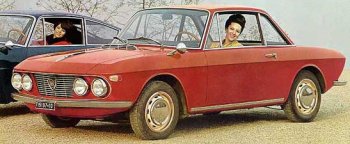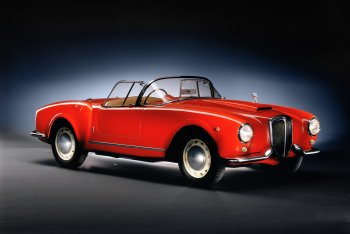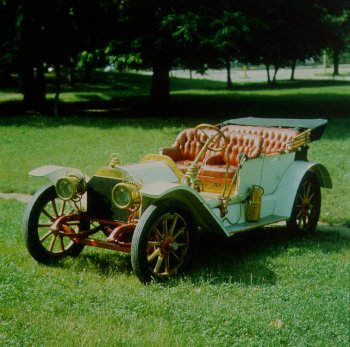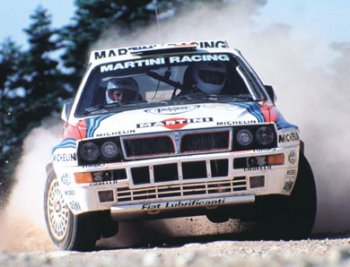|
To celebrate their centenary,
Lancia will exhibit four
extraordinary historical cars at the Geneva Motor Show, recalling four important moments in the brand’s long and
glorious history: the Beta Torpedo 15 HP, Aurelia GT B24
Spider, Fulvia Coupé 1.2 (first series) and Delta HF
integrale EVO Martini gr.4. These cars were immortalised by
Fulvio
Bonavia, one of the best-known Italian photographers, in the
calendar ‘1906-2006: Once upon a time …’ with which Lancia
inaugurated the celebrations for its centenary year.
Designed by the Armando Testa agency, the
calendar considers one hundred years of Lancia automotive
creations, combining them with ‘fairy-tale inventions’.
The result is an
extraordinary gallery of pictures in which the attractive
Beta Torpedo challenges the beauty of Snow White, the
Aurelia GT tells the story of Cinderella’s dream, the
Aurelia Spider dispatches Little Red Riding Hood’s wolf, and
the Fulvia flies with Hook and Peter Pan. Then there is the
Delta Rally that receives the kiss of victory like the Frog
Prince, and the Ypsilon that enters Alice’s Wonderland. On
every page the magical styling of the Lancia cars combines
with the fairy-tale characters and atmosphere, and the
enchanted landscapes of the poetic narrative is interwoven
with a legendary history of cars and designers, races and
engines that have been milestones in technical progress and
racing throughout the 20th century.
It was 1906 when Vincenzo
Lancia wrote the first page of the amazing adventure that
would involve thousands of people over the years –
technicians, workers, managers – in the plants, offices and
the racing world. And with them, the many Lancia customers:
passionate, demanding, in love with beauty, but also well
informed about the most sophisticated technologies. Here we
find the roots of the inimitable personality that enables us
to immediately distinguish a Lancia car from all the others
on the road. And today, the fantasy world of the fairy-tale
and the real world of Lancia meet in Fulvio Bonavia’s
photographs, which highlight the ways that both have brought
the dreams of whole generations to life with great artistic
sensitivity.
The Beta Torpedo 15 HP of 1909.
The car was a success on the market and 150 were built in
1909 alone; it was used in races and took outright third
place in the Targa Florio in 1909. That same year, driven by
W.L. Stewart, it set a speed of 106.22 km/h at the British
circuit of Brooklands. The car on show in Geneva is powered
by a straight-4, 3117 cc monobloc engine that delivers a
maximum power output of 34 bhp at 1850 rpm and has a top
speed of 95 km/h.
The Aurelia Gran Turismo 2500 Spider of 1955.
A total of 761 were manufactured between 1954 and 1958; the
car was the result of one of Pinin Farina’s most classical
and attractive designs, and the designer himself described
it as the prototype Italian convertible, commonly known as
the B 24. It had its preview in a pre-production version in
June 1954, and made its official debut on the international
stage at the Brussels Motor Show in January 1955. The
Aurelia Gran Turismo 2500 Spider was destined primarily for
the American market, but with a few small changes it was a
success on all markets. We should remember that the Spider
was the original version, whereas the second series was
known as the Convertible ‘tipo America’, because of the
success it enjoyed on that market. Equipped with a 2451 cc
6-cylinder engine in a 60° Vee that delivered a maximum of
118 bhp at 5300 rpm, the Aurelia Gran Turismo 2500 Spider
had a top speed of 180 km/h.
|
 |
|
The Fulvia Coupé 1st series
(1967): The coupé version of the Fulvia was presented in 1965. The
styling by Piero Castagnero was extremely modern: a slender,
sleek car with generous glazing and a Cd of 0.39. |
|
 |
|
The Aurelia Gran Turismo 2500 Spider of 1955:
A total of 761 were manufactured between 1954 and 1958; the
car was the result of one of Pinin Farina’s most classical
and attractive designs, and the designer himself
described it as the prototype Italian convertible,
commonly known as the B 24. |
|
|
 |
|
The Beta Torpedo 15 HP of 1909:
The car was a success on the market and 150 were built in
1909 alone; it was used in races and took outright third
place in the Targa Florio in 1909. That same year, driven by
W.L. Stewart, it set a speed of 106.22 km/h at the British
circuit of Brooklands. |
|
 |
|
The Delta HF integrale EVO
Martini gr.4 (1992): A car that needs no introduction. Its
story began in the Autumn of 1979 when the Lancia Delta was
launched with huge success (voted Car of the Year 1980). |
|
|
The Fulvia Coupé 1st series
(1967).
The coupé version of the Fulvia was presented in 1965. The
styling by Piero Castagnero was extremely modern: a slender,
sleek car with generous glazing and a Cd of 0.39. It was
initially equipped with a 1216 cc 4-cylinder engine in a
narrow 13° Vee delivering 79 bhp at 6000 rpm, with a top
speed of 160 km/h (and subsequently by the more powerful
1300 and 1600 engines), and guaranteed agility and handling
that the saloon could not match, partly because the
wheelbase was 15 centimetres shorter and the weight was
considerably lower.
The more powerful, but
lighter HF and Sport Zagato versions were developed to
compete in rallies, and they won thousands of victories, the
most famous being the 1972 Monte Carlo Rally, and the
outright victory that same year in the F.I.A. Cup, which
later became the World Rally Championship. The revamped
second series was presented in 1969 with the engine capacity
increased to 1298 cc, the wheelbase extended by 20 mm and
more harmonious lines and volumes; the engine delivered 85
bhp and the car had a top speed of 168 km/h. By the time
production terminated in 1976 with the Coupé 3, a total of
about 140,000 had been built in eleven years.
The Delta HF integrale EVO Martini gr.4
(1992).
A car that needs no introduction. Its story began in the
Autumn of 1979 when the Lancia Delta was launched with huge
success (voted Car of the Year 1980). The merit went to its
beautiful line, compact and highly innovative, designed by
Giorgetto Giugiaro, combined with the quality of the
engineering and the materials adopted, and the excellent
technical structure. But the public had its first glimpse of
what was to become the most important version of this model
at the 1982 Turin Motor Show, when a prototype four-wheel
drive Delta was presented; this version anticipated the
definitive version of 1986 known as the Delta HF 4WD, which
had permanent four-wheel drive, and would remain in
production until 1994, evolving over the years. It made its
racing debut in the 1987 World Rally Championship and won
the world title for six consecutive years, from 1987 to
1992, a record that is still unbeaten. The Delta HF
integrale EVO Martini gr.4 (1992) was equipped with a
straight-4, 16-valve engine with a turboblower (and a
capacity of 1995 cc), which delivered an amazing 300 bhp,
taking it to a top speed of over 215 km/h (depending on the
ratios).
|
|
|
|
![]()
![]()